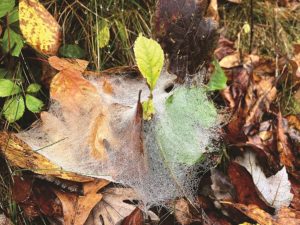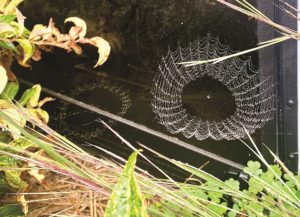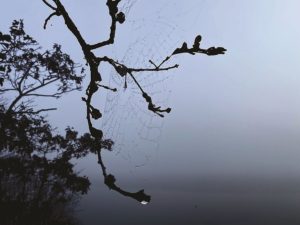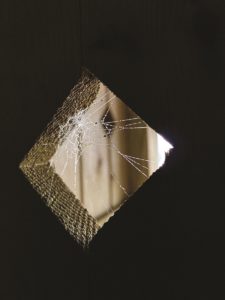This is the season of misty mornings. The air is heavy with moisture that settles into the fields and forests as the sun rises. As this veil of dew comes to rest, it collects on the most delicate of things, bringing the invisible into view.
Frosted white structures, tiny laceworks spun by master weavers, seem suddenly to appear. Silk threads reach from branch to twig, delicate lines beaded with drops of water. A lawn is no longer a swath of grass but a million tent-poles supporting a thousand tiny webs. The forest floor is covered not only by fallen leaves but by a patchwork of spun filaments that look like footsteps left by ghosts.

Spiderwebs are everywhere. It is estimated that there are around 80,000 spiders per acre of land. Most of them are web makers. Most times, we notice their work only when a web spans the path we are walking or appears overnight in the corner of the living room. But on these fall mornings, we see that they are as much a part of our landscape as the leaves and blades of grass on which they rest.
They are in the cracks in the bark, beneath the soil, high in the branches, suspended over rafts of moss, in every curl and bend of every natural form. They are always there, these masterworks of natural engineering, intricate wonders worthy of display in a museum.
When we slow down and look closely, crouching to ground level or standing on our tippytoes to nearly touch our noses to them, we find these webs are spun and composed in a variety of designs.

The one we know best is the orb web, made up of radiating support spokes with connective lines spiraling outward from the center. If you were to ask a child to draw a spiderweb, this is the one she would make. There are funnel webs that sit like low trampolines in the underbrush, their wide spans narrowing to a tunnel where the spider hides and waits. Tangle webs, or cobwebs, look chaotic and disorganized. This is by design. Their unpredictability offers no consistent pattern for prey to navigate. Sheet webs stand in the landscape like circus tents, their central supports a twig, a shoot of grass, or any small rise in the lay of the terrain.
Spiders spin specialized protective cocoons for molting and spherical woolly egg-sacs that swaddle a thousand baby web builders. These are all revealed when their lines are given weight by the morning dew: examples of perfect function, taught and learned by nature.

The silk itself is a miraculous material, a fine thread composed of proteins. Stronger by weight than steel, it is elastic, light, organic. In a liquid state inside the spider, it is drawn from the lower abdomen by the spider’s hind legs out through structures called spinnerets and spigots. The silk is punctuated with droplets of glue that activate in the presence of resistance — the harder it is struggled against, the faster it holds.
The spider traces a framework, climbing upon its own lines, withdrawing this silver thread from itself, and connecting it at key points along the way to build its functional art. There is an innate map within the spider’s makeup that directs the precise patterning and layout of the web. Divine geometry spun through thin air.

Spider silk is electrically conductive. Individual threads will flex and spring toward prey, which tend to be statically charged from their movement. This electrostatic property also allows their creators to fly and move across great distances through a process called ballooning. Silk is let out into air currents and drawn upward by Earth’s electrically charged atmosphere. When enough charge has been gathered, the silk lifts, pulling the spider into the air. When you see a web spun across a distance that seems insurmountable to such a tiny creature, this is how it is done.
And yet we fear them. Spiderwebs elicit a natural response of withdrawal, some ancient biological warning, telling us to stay away. Very few spiders on Cape Cod are venomous, however. As the early morning dew settles and brings a world seldom seen into being, we are given an opportunity to lean in and look more closely, to move toward something that makes us uncomfortable and perhaps discover miraculous beauty there.
